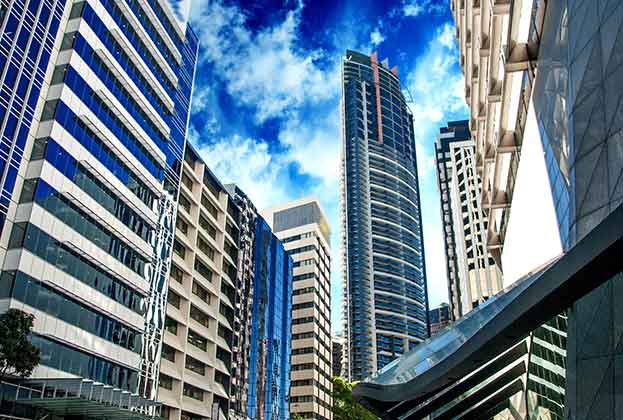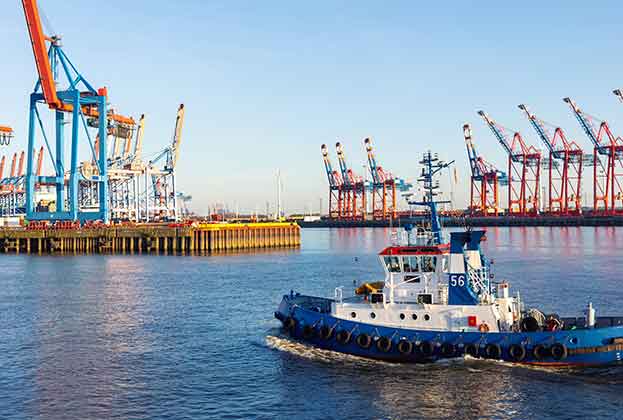The US office sector remains the problem child of global commercial real estate
Europe, Middle East, and Africa (EMEA)
Uncertainty around the policy environment continues to inhibit investment activity in the UK. Persistent upside surprises in inflation data forced the Bank of England to hike by 50 bps in June, with market expectations for the terminal rate pushing past 6.25% in the same month. This was more than 150 bps higher than markets were pricing at the beginning of the year, and above the level reached while the economy was under the short, yet now infamous, stewardship of Liz Truss. It has since dropped back after an encouraging June inflation print, but markets are tetchy, sensitive to small deviations in the data.
Interest rate volatility prompted a further outward shift in the prime benchmark yield for the City of London to 5% in the second quarter, albeit there is now a sense that it may stabilise over the next 12 months. Investment turnover in the first half of the year was more than 40% down on the five-year average, but a more stable macroeconomic environment should encourage investors to return, especially if more sales are launched to the market to pique their interest. Some large US institutions are window-shopping again, and Asia Pacific privates are buying. The occupational backdrop remains relatively resilient, particularly at the top end of the market; while take-up was down by around 17% on the long-term average in Q2, active requirements breached 9 million sq ft for the first time on record, and rents are up by more than 10% on the year.
Across mainland Europe, interest rate volatility and macroeconomic uncertainty also remain front and centre for investors, underpinning a broad-based slowdown in investment. Year to date, investment volumes across the euro area are down by nearly 64% in comparison with the same period last year. Benchmark prime yields in Frankfurt and Madrid moved out again this quarter by 20 bps and 25 bps, respectively.
But despite the relative uniformity across capital markets activity, there is more divergence across occupational markets; while take-up in Madrid was broadly stable in the first half of the year, it was down by nearly one-quarter in the Paris CBD. And yet the vacancy rate continued to fall in the latter to 2%, the lowest since before the Covid-19 pandemic, with a lack of supply helping to cushion the market and support rents
Across the top 6 office markets, the 1.05 million sq ft of take-up in H1 was more than one-third down on the same period last year, with Q2 representing one of the weakest quarters in recent memory
Oliver Salmon, Global Capital Markets, World Research
In the German market, the occupational market is beginning to take a turn for the worse, mirroring the fortunes of Europe’s largest economy. Across the top 6 office markets, the 1.05 million sq ft of take-up in H1 was more than one-third down on the same period last year, with Q2 representing one of the weakest quarters in recent memory. With vacancy rates rising, there is growing downward pressure on rents. This will compound the impact of a further outward shift in yields, which is expected, on asset values.
North America
The US office sector remains the problem child of global commercial real estate. The narrative is well established; occupational demand has decoupled from employment, given a pervasive adoption of work from home. Large amounts of space is being returned to the market, driving vacancy levels to record levels. Investment volumes were nearly 60% down on the year, with just US$12.3 billion in transactions in Q2.
Prices are in decline as a result, and probably have further to fall. This is reflected by public market valuations, with US office REITs currently trading at a median discount to NAV of over 40%, according to S&P Global, compared with an all-property average of 18%.
While the overall delinquency rate remains low, the office market has seen a number of high-profile defaults, with several major institutions preferring to surrender the keys on buildings rather than continue to service the outstanding debt. Major banks are increasing their loan loss provisions in anticipation of more distress.
But concerns linger over the health of the banking sector, which means that credit conditions will continue to tighten
Oliver Salmon, Global Capital Markets, World Research
Refinancing will be a major challenge for landlords. Fears of a deposit-driven crisis across regional banks have faded in recent months. But concerns linger over the health of the banking sector, which means that credit conditions will continue to tighten. Meanwhile, CMBS issuance has largely dried up, withdrawing another important source of liquidity in debt markets, and non-bank lenders are largely avoiding anything using an office as collateral.
One market where the distress has already arrived is Los Angeles. The only major deal this year, Union Bank Plaza, exchanged at a 50% discount to the original purchase price from over a decade ago. Brookfield has reportedly defaulted on US$1.1 billion of loans across three downtown buildings. The weak occupational market is weighing heavily on any prospects for recovery; the availability rate hit a new record of 26.6% in Q2 as leasing activity continues to slow. Most discretionary lease deals are now being delayed, and rents are starting to decline amid fierce competition for tenants. This is compounding the impact of a higher benchmark yield on asset values, which rose by another 100 bps to 8% this quarter.
The occupational market in New York is also subdued. Leasing activity is around 25% below pre-pandemic norms, and the availability rate continues to rise, up 20 bps to 19.7% in Q2. With both tech and media now largely absent from leasing markets, the concern for New York is that layoffs in Wall Street are just beginning to accumulate. Capital markets were buoyed by the completion of several large deals this quarter, including 245 Park Avenue, providing evidence that the top end of the market continues to hold up. This supports a benchmark yield holding steady at 5%, although we do expect further expansion in the next 12 months.
Asia Pacific
Asia Pacific remains a bastion of relative stability. Throughout the region, fundamentals remain largely positive, especially in the prime segment. Yields are unchanged as a consequence, except in Sydney, where the prime yield rose by 18 bps as the 10-year bond yield pushed past 4% for the first time since January. And yet large institutional investors are increasingly turning away from offices, even at discounted values, as the bearish attitude in the US seeps into the psyche of investment committees around the world. Investment volumes were down by 55% y/y in Q2 across the region.
.jpg)
This trend is most evident in Japan, where investors are increasingly focusing exclusively on logistics and residential. Cross border investors have accounted for less than 6% of transactions this year, compared with an average of over 37% across other sectors. Nevertheless, occupational demand is stabilising in line with the economy, which continues to exhibit reasonable momentum following the relaxation of Covid-19 restrictions. Average rents for Grade A space continued to fall in Q2, but the declines are moderating amid falling vacancy. And while there is some concern that this narrative will be derailed by the onboarding of new supply through the remainder of this year, pre-leasing activity suggests little disruption.
Excess in supply is, however, a growing concern for investors in China. In Shanghai, the vacancy rate pushed past 10% in Q2, rising by 1.8 percentage points in the quarter. Leasing activity has yet to see a meaningful recovery following the relaxation of Covid-19 restrictions, and it is unlikely to do so now the economic recovery is quickly losing steam.
Interest rates are moving against the grain in China as the PBoC cuts benchmark rates to help support the economy. But there remains a limited pool of investors, particularly for large assets, so pricing will need to adjust regardless.
Hong Kong, too, is suffering from an oversupplied office market. High and rising vacancy suggests the ongoing rental correction (down 33% from 2019 peaks) has further to run. When also considering the arithmetic between entry yields and the cost of debt, it is unsurprising that there have been no major transactions this year.
Singapore, too, is seeing some rental growth, particularly for premium space, despite the challenging macroeconomic environment
Oliver Salmon, Global Capital Markets, World Research
By contrast, the outlook for supply favours landlords in Seoul. Indeed, pricing is showing signs of stabilising amid a major undersupply of new stock, with a vacancy rate of just 1.8% and a pipeline that includes no major completions between now and late-2026. This would imply a peak-to-trough decline in asset values of 10-15% through this cycle, albeit with plenty of upside potential, with market rents rising by a healthy 7% YoY in Q2.
Strong rental growth is helping to justify a 4.05% entry yield, despite the paltry risk premium of less than 40 bps to the risk-free rate. But investor appetite will be tested as numerous large deals hit the market later this year. Much depends on whether the Bank of Korea resumes hiking interest rates after pausing for the previous four consecutive meetings.
Singapore, too, is seeing some rental growth, particularly for premium space, despite the challenging macroeconomic environment. Occupational demand is leveraged to a slowdown in the tech sector, and net take-up of Grade A space in the CBD has now declined for three consecutive quarters. But many large tenants are locked into long leases – which is leading to a rise in shadow space returned to the market, but with little impact on underlying rents. Furthermore, the lack of new supply is again insulating the market against a cyclical decline in demand.
Read the articles within Taking Stock: Capital Markets Quarterly – Q2 2023 below.
.jpg)




